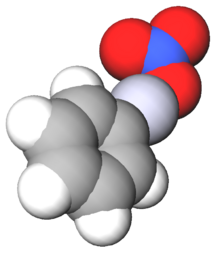Chemistry:Phenylmercuric nitrate
From HandWiki
Short description: Organomercury compound with powerful antiseptic and antifungal effects

| |

| |
| Names | |
|---|---|
| IUPAC name
nitrooxy(phenyl)mercury
| |
| Identifiers | |
3D model (JSmol)
|
|
| ChEBI | |
| ChemSpider | |
| EC Number |
|
PubChem CID
|
|
| RTECS number |
|
| UNII | |
| UN number | 1895 |
| |
| |
| Properties | |
| C6H5HgNO3 | |
| Molar mass | 339.702 g/mol |
| Melting point | 176–186 °C (349–367 °F; 449–459 K) |
| Hazards | |
| Main hazards | Toxic |
| GHS pictograms |    
|
| GHS Signal word | Danger |
| H301, H314, H372, H410 | |
| P260, P264, P270, P273, P280, P301+310, P301+330+331, P303+361+353, P304+340, P305+351+338, P310, P314, P321, P330, P363, P391, P405, P501 | |
Except where otherwise noted, data are given for materials in their standard state (at 25 °C [77 °F], 100 kPa). | |
| Infobox references | |
Phenylmercuric nitrate is an organomercury compound with powerful antiseptic and antifungal effects.[1] It was once commonly used as a topical solution for disinfecting wounds, but as with all organomercury compounds it is highly toxic, especially to the kidneys, and is no longer used in this application. However it is still used in low concentrations as a preservative in eye drops for ophthalmic use, making it one of the few organomercury derivatives remaining in current medical use.[2]
See also
References
- ↑ Xu, Y.; He, Y.; Li, X.; Gao, C.; Zhou, L.; Sun, S.; Pang, G. (2013). "Antifungal effect of ophthalmic preservatives phenylmercuric nitrate and benzalkonium chloride on ocular pathogenic filamentous fungi". Diagnostic Microbiology and Infectious Disease 75 (1): 64–7. doi:10.1016/j.diagmicrobio.2012.09.008. PMID 23102555.
- ↑ Kaur, I. P.; Lal, S.; Rana, C.; Kakkar, S.; Singh, H. (2009). "Ocular preservatives: Associated risks and newer options". Cutaneous and Ocular Toxicology 28 (3): 93–103. doi:10.1080/15569520902995834. PMID 19505226.
 |

